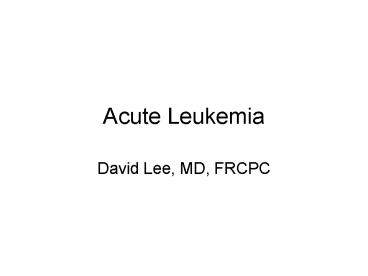Acute Leukemia - PowerPoint PPT Presentation
1 / 31
Title:
Acute Leukemia
Description:
usually fatal within weeks to months without chemotherapy ... curative vs palliative intent. Principles of treatment. combination chemotherapy ... – PowerPoint PPT presentation
Number of Views:59
Avg rating:3.0/5.0
Title: Acute Leukemia
1
Acute Leukemia
- David Lee, MD, FRCPC
2
Overview
- Concepts, biology
- Epidemiology
- Clinical and laboratory manifestations
- Diagnosis
- Management and prognosis
3
Classification of leukemias
Acute
Chronic
Myeloid origin
Acute Myeloid Leukemia (AML)
Chronic Myeloid Leukemia (CML)
Lymphoid origin
Acute Lymphoblastic Leukemia (ALL)
Chronic Lymphocytic Leukemia (CLL)
4
(No Transcript)
5
Myeloid maturation
MATURATION
Adapted and modified from U Va website
6
Acute Leukemia
- accumulation of blasts in the marrow
7
How to distinguish AML vs CMLfrom looking at
peripheral blood
- Myeloid cell CML AML normal
- blasts q q
- promyelocytes q
- myelocytes q
- metamyelocytes q
- bands q
- neutrophils q q
8
Significance of adult acute leukemia
- a hematologic urgency
- usually fatal within weeks to months without
chemotherapy - with treatment, high mortality due to disease or
treatment-related complications (unlike childhood
acute leukemia) - notify Hematologist promptly if acute leukemia is
suspected
9
Classification of acute leukemias
- ALL
- mainly children
- M gt F
- curable in 70 of children
- curable in minority of adults
- AML
- mainly adults
- M gt F
- curable in minority of adults
10
Two-hit model of leukemogenesis
Gain of function mutations of tyrosine
kinases eg. FLT3, c-KIT mutations N- and
K-RAS mutations BCR-ABL TEL-PDGFbR
Loss of function of transcription factors needed
for differentiation eg. AML1-ETO
CBFb-SMMHC PML-RARa
differentiation block
enhanced proliferation
Acute Leukemia
11
Causes of acute leukemias
- idiopathic (most)
- underlying hematologic disorders
- chemicals, drugs
- ionizing radiation
- viruses (HTLV I)
- hereditary/genetic conditions
12
Clincal manifestations
- symptoms due to
- marrow failure
- tissue infiltration
- leukostasis
- constitutional symptoms
- other (DIC)
- usually short duration of symptoms
13
Marrow failure
- neutropenia infections, sepsis
- anemia fatigue, pallor
- thrombocytopenia bleeding
14
Infiltration of tissues/organs
- enlargement of liver, spleen, lymph nodes
- gum hypertrophy
- bone pain
- other organs CNS, skin, testis, any organ
15
Gum hypertrophy
16
Chloromas
NEJM 1998
17
Leukostasis
- accumulation of blasts in microcirculation with
impaired perfusion - lungs hypoxemia, pulmonary infiltrates
- CNS stroke
- only seen with WBC gtgt 50 x 109/L
18
Constitutional symptoms
- fever and sweats common
- weight loss less common
19
Laboratory features
- WBC usually elevated, but can be normal or low
- blasts in peripheral blood
- normocytic anemia
- thrombocytopenia
- neutropenia
- DIC
20
Bone marrow in acute leukemia
- necessary for diagnosis
- useful for determining type
- useful for prognosis
- Acute leukemias are defined by the presence of gt
20 blasts in bone marrow ( of nucleated marrow
cells)
21
Distinguishing AML from ALL
- light microscopy
- AML Auer rods, cytoplasmic granules
- ALL no Auer rods or granules.
- flow cytometry
- special stains (cytochemistry)
22
AML
23
AML
24
Auer rods in AML
25
ALL
26
Treatment of acute leukemias
- Choice of Rx is influenced by
- type (AML vs ALL)
- age
- curative vs palliative intent
27
Principles of treatment
- combination chemotherapy
- first goal is complete remission
- further Rx to prevent relapse
- supportive medical care
- transfusions, antibiotics, nutrition
- psychosocial support
- patient and family
28
Chemotherapy for acute leukemias
- Phases of ALL treatment
- induction
- intensification
- CNS prophylaxis
- maintenance
- Phases of AML treatment
- induction
- consolidation (post-remission therapy)
post-remission therapy
29
Hematopoietic stem cell transplantation
- permits rescue from otherwise excessively toxic
treatment - additional advantage of graft-vs-leukemia effect
in allogeneic transplants - trade-off for allogeneic transplantation greater
anti-leukemic effect but more toxic
30
Prognosis
Adult AML
Adult ALL
similar to or worse than AML
31
Overview
- Concepts, biology
- Epidemiology
- Clinical and laboratory manifestations
- Diagnosis
- Management and prognosis































